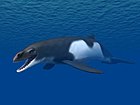
In anatomy, the atlas (C1) is the most superior (first) cervical vertebra of the spine and is located in the neck. It is named for Atlas of Greek mythology because, just as Atlas supported the globe, it supports the entire head.

The tibia, also known as the shinbone or shankbone, is the larger, stronger, and anterior (frontal) of the two bones in the leg below the knee in vertebrates, and it connects the knee with the ankle bones. The tibia is found on the medial side of the leg next to the fibula and closer to the median plane or centre-line. The tibia is connected to the fibula by the interosseous membrane of leg, forming a type of fibrous joint called a syndesmosis with very little movement. The tibia is named for the flute tibia. It is the second largest bone in the human body next to the femur. The leg bones are the strongest long bones as they support the rest of the body.

Zygorhiza ("Yoke-Root") is an extinct genus of basilosaurid early whale known from the Late Eocene of Louisiana, Alabama, and Mississippi, United States, and the Bartonian to the late Eocene of New Zealand . Specimens reported from Europe are considered Dorudontinae incertae sedis.

Aetiocetus is a genus of extinct basal mysticete, or baleen whale that lived 33.9 to 23.03 million years ago, in the Oligocene in the North Pacific ocean, around Japan, Mexico, and Oregon, U.S. It was first described by Douglas Emlong in 1966 and currently contains known four species, A. cotylalveus, A. polydentatus, A. tomitai, and A. weltoni. These whales are remarkable for their retention of teeth and presence of nutrient foramina, indicating that they possessed baleen. Thus, Aetiocetus represents the transition from teeth to baleen in Oligocene mysticetes. Baleen is a highly derived character, or synapomorphy, of mysticetes, and is a keratinous structure that grows from the palate, or roof of the mouth, of the whale. The presence of baleen is inferred from the fossil record in the skull of Aetiocetus. Aetiocetus is known from both sides of the Pacific Ocean: it was first documented in Oregon, United States, but it is also known from Japan and Mexico. The genus is currently constrained to the Northern hemisphere and has little value in biostratigraphic studies of the Oligocene due to its limited occurrences across the Pacific.

Labidosaurikos is a genus of extinct captorhinid anapsid reptile that lived around 279 to 272 million years ago during Kungurian age of the lower Permian. The American Paleontologist John Willis Stovall first described Labidosaurikos in 1950, naming it "Labidosaurus like" for the striking similarity of the holotype skull of his specimen to the cranial anatomy of another captorhinid Labidosaurus hamatus. Labidosaurus or generally called "lipped lizard" is another genus of the family Captorhinidae whose name is derived from the Greek "forceps lizard" based on τσιμπίδα and σαυρος ("lizard")
Eomysticetus is an extinct genus of baleen whale from the late Oligocene (Chattian) Chandler Bridge Formation of South Carolina.
Mauicetus is a genus of extinct baleen whale from the Late Oligocene of New Zealand.
Tohoraata is a genus of eomysticetid baleen whale from the Late Oligocene (Chattian) of New Zealand. There are two recognized species, T. raekohao and T. waitakiensis.
Eomysticetidae is a family of extinct mysticetes belonging to Chaeomysticeti. It is one of two families in the basal chaeomysticete clade Eomysticetoidea.

Brandtocetus is a genus of cetotheriid mysticete in the subfamily Cetotheriinae. The type and only species is Brandtocetus chongulek from the late Miocene (Tortonian) of the Kerch Peninsula in Crimea.

Allodelphis is an extinct genus of whale belonging to Allodelphinidae found in marine deposits of the eastern North Pacific.

Waharoa is a genus of eomysticetid baleen whale from the Late Oligocene (Chattian) of New Zealand. It was identified with the discovery of Waharoa ruwhenua by Boessenecker and Fordyce (2015), which added a new genus and species to a monophyletic family Eomysticetidae.

Horopeta is a genus of baleen whale from the Late Oligocene (Chattian) Kokoamu Greensand of New Zealand.
Whakakai is a genus of baleen whale from the Late Oligocene (Chattian) Kokoamu Greensand of New Zealand.
Eodelphinus is an extinct genus of oceanic dolphins belonging to the family Delphinidae.
Toipahautea is a genus of baleen whale from the Late Oligocene (Chattian) Kokoamu Greensand of New Zealand.
Yamatocetus canaliculatus is an extinct species of eomysticetid baleen whale from the Late Oligocene of Japan.

Chinatichampsus is an extinct genus of crocodilian from the Devil's Graveyard Formation of Texas, specifically the Dalquest Desert Research Site. It is a monotypic genus, containing only the type species Chintanichampsus wilsonorum. A single specimen, TMM 45911–1, was first discovered in 2010. Chinatichampsus is the most basal Eocene caimanine, dating to between 42.8 and 41.5 million years ago, and is considered to be more basal than Protocaiman.

Antaeusuchus taouzensis is a species of peirosaurid notosuchian from the Late Cretaceous Kem Kem Group of Morocco described in 2021, and the only species in the genus Antaeusuchus. It is the fourth notosuchian described from the region and the second Kem Kem peirosaurid after Hamadasuchus.
Ultrastenos is an extinct genus of Australian mekosuchine crocodilian first described in 2016. The type species Ultrastenos willisi was discovered at Riversleigh in northwestern Queensland, Australia, and lived during the Late Oligocene era.














